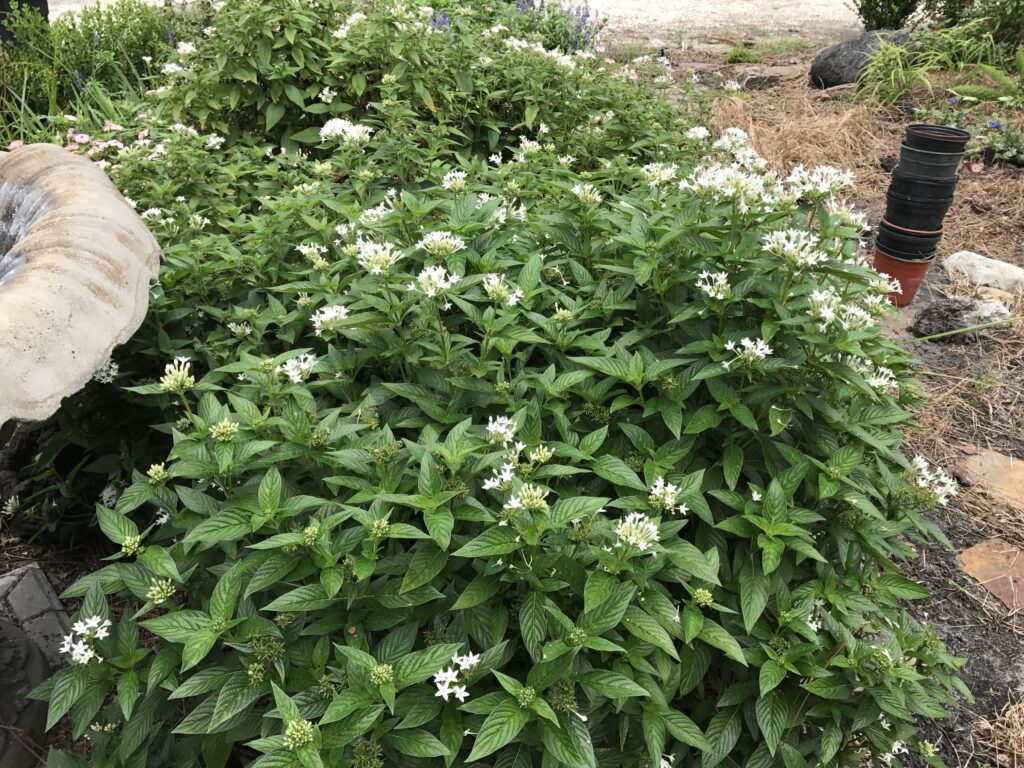Pentas Butterfly Series Mixed Hybrids
( Pentas Hybrid Butterfly Mix)

Pentas Butterfly Mixed Hybrids Origins:
Native to tropical regions of Africa.
This mid size compact selection of an old garden favorite provides a long lasting bloom season perfect for middle of the border plantings for our North Florida | Jacksonville | St. Augustine area hot humid summers.
Pentas Butterfly Mixed Hybrids Preferred Exposure:
– Pentas Butterfly Mixed Hybrids will prefer a full sun or partial shade
partial sun location.
Pentas Butterfly Mixed Hybrids Foliage:
– Medium green compact foliage
Pentas Butterfly Mixed Hybrids Soil Preference / Salt tolerance:
– Pentas Butterfly Mixed Hybrids is not particular about the components of the soil it is planted in providing they are planted in a well draining location.
– Salt tolerance for Pentas Butterfly Mixed Hybrids is unknown.
Pentas Butterfly Mixed Hybrids Size Variance:
– Pentas Butterfly Mixed Hybrids is a lower growing Pentas selection only
reaching 18-22 inches in height and 14-18 inches in width! This series is kind of the best of both worlds for me and really still has all of the butterfly attracting pollen of the larger older pentas with a combined more compact habit that keeps you from having to trim to keep your plant from toppling over in a NE Florida summer rain storm. For me this variety is about knee height in the landscape in its second season or even by the end of the first growing season. Its the perfect middle of the border plant and does well in mixed containers, as long as they are large ones!
Pentas Butterfly Mixed Hybrids Growth Habit:
– Densely foliated plants are well branched and tend to be as wide as they are tall forming a mounded habit.
Pentas Butterfly Mixed Hybrids Growth Rate:
– Fast growing Pentas Butterfly Mixed Hybrids can be expected to reach its full height in the first season in the North Florida | Jacksonville | St. Augustine area landscape.
Pentas Butterfly Mixed Hybrids Bloom:
– Three inch wide clusters of star shaped tubular blooms in late spring summer and fall. The “Butterfly Series Mix contains colors in a bright white / soft bubblegum pink / bright red / pale Lavender/ Blush- super light pink and deep cherry rose colored blooms. Really very showy blooms that have lots of nectar to feed the pollinators and man do they attract them!
Pentas Butterfly Mixed Hybrids Water Requirements:
– Although Pentas are in general very drought tolerant plants and at home in sandy soil gardens like the others, the Butterfly Series Mixed Hybrids will require supplemental irrigation for best results.
Butterfly or Bird Attracting:
– Pentas Butterfly Mixed Hybrids will attract butterflies to your gardens landscape. Hummingbirds will be attracted in particular to the Red selection.
Best Uses For Pentas Butterfly Mixed Hybrids in the North Florida | Jacksonville |
St. Augustine area garden:
– Pentas Butterfly Mixed Hybrids will perform well in the North Florida landscape. They are a great low maintenance plant selection for loads of booms with almost no maintenance after planting. The medium sized height fits nicely into more modern landscapes and can easily be incorporated into any landscape setting.
– Butterfly and hummingbird attracting flower!
– Pentas Butterfly Mixed Hybrids makes a great companion plant for other perennials in the garden and adds an instant cottage garden feel when planted in any landscape.
– Plant in masses for easy maintenance blooms that make a great flowering display all during the spring summer and fall seasons in the North Florida | Jacksonville | St. Augustine area landscapes.
Care of Pentas Butterfly Mixed Hybrids in the North Florida | Jacksonville | St.
Augustine area landscape:
– Water every day during the establishment period after planting in the garden from a nursery container, once plants have established themselves into the landscape taper water back to just a weekly application if local rainfall levels are low.
– Perennial in central and south Florida this selection of Pentas is most often
planted as an annual and replaced at the end of the season with cool season annuals in our North Florida climate. I like to leave the foliage and roots in place, covering the base of the plant with a thick layer of pine straw that you can remove the following spring and trim off dead stalks above where the new growth appears the following spring season )
– Fertilize each spring and again in mid summer and fall with a handful of garden compost or a mixture of Milorganite and a slow release poly coated plant food such as Osmocote or Stay Green general purpose plant food
or 10-10-10.

